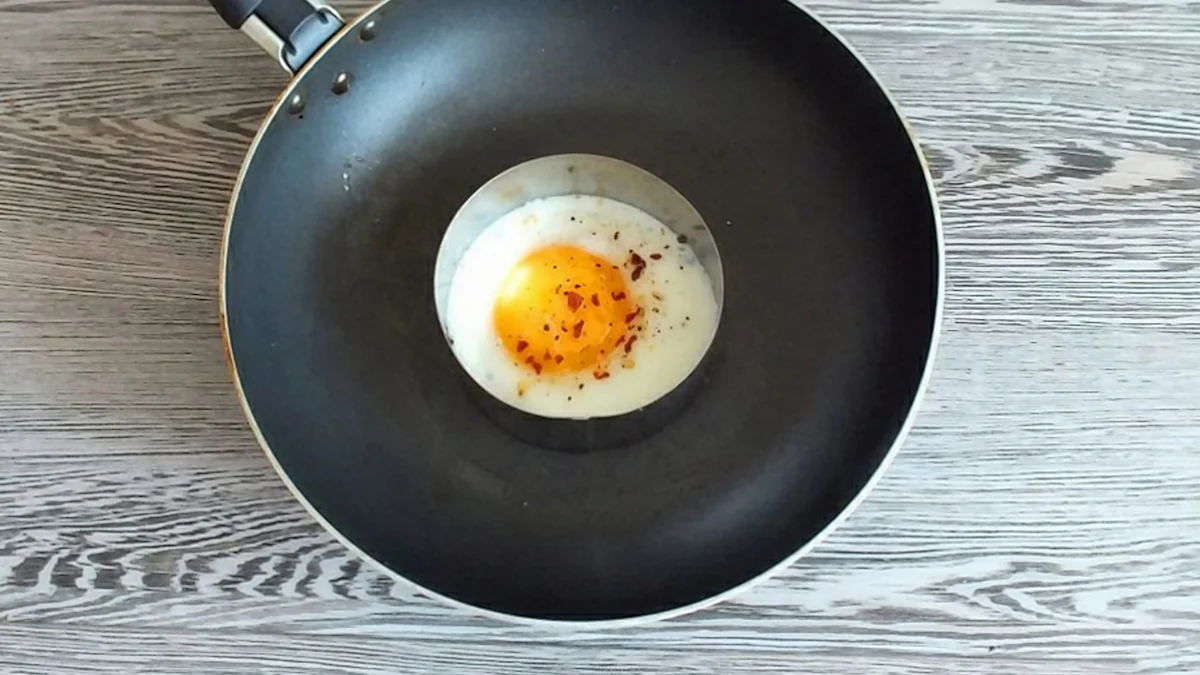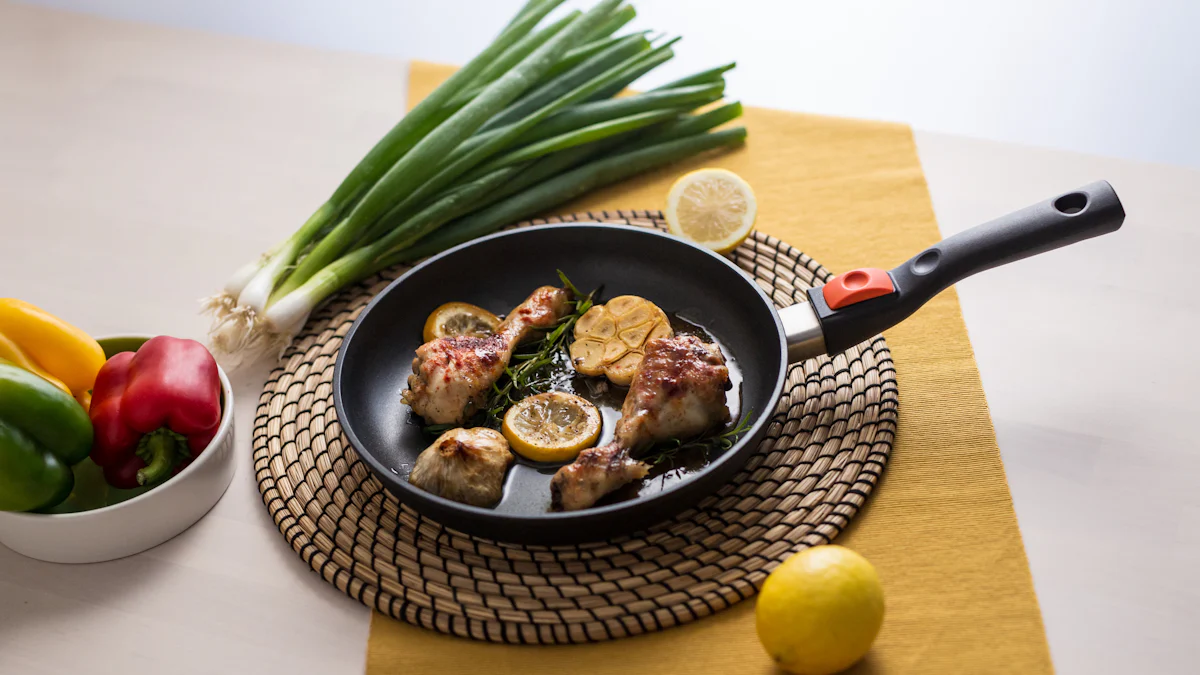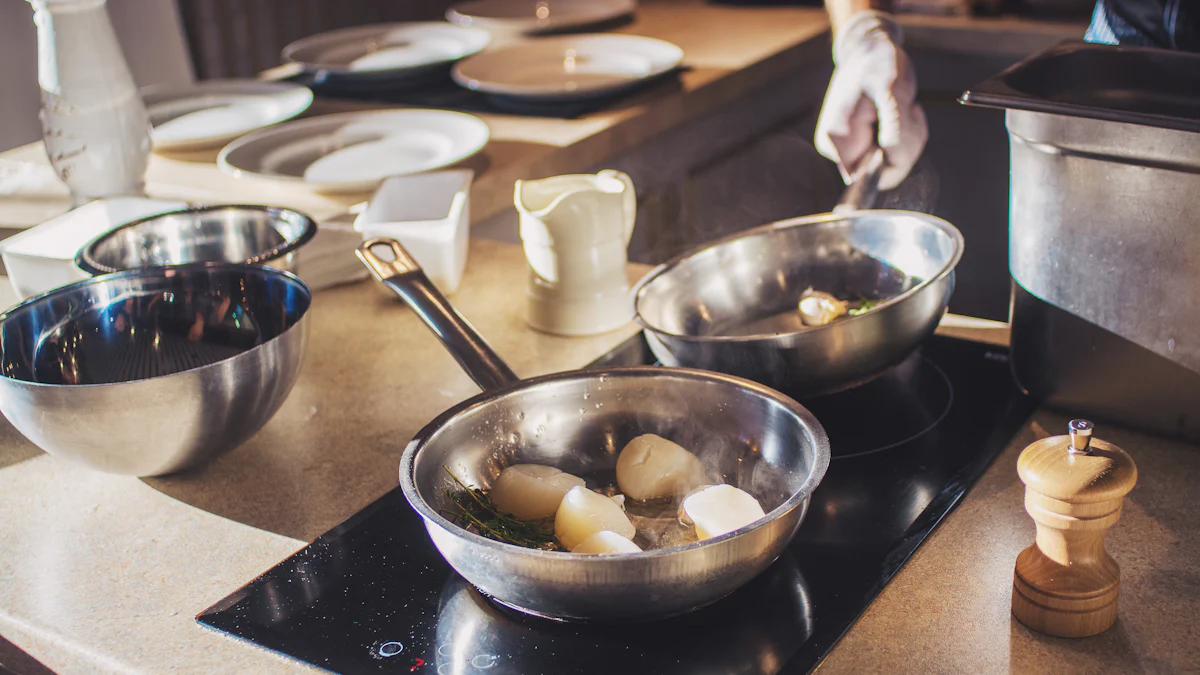PTFE vs Ceramic Nonstick Coatings in Aluminum Cookware

Nonstick coatings have revolutionized cooking by offering convenience and efficiency. PTFE and ceramic coatings, commonly used in aluminum cookware, stand out for their unique properties. PTFE delivers exceptional nonstick performance and long-lasting durability, making it a favorite among professional chefs. Ceramic coatings, on the other hand, appeal to eco-conscious individuals due to their chemical-free composition and environmental benefits. Selecting the ideal coating requires careful consideration of factors like cooking habits, safety priorities, and budget constraints. Each option caters to different needs, ensuring a tailored cooking experience.
Key Takeaways
- PTFE coatings offer superior nonstick performance and durability, making them ideal for frequent cooking.
- Ceramic coatings are eco-friendly and free from harmful chemicals, appealing to health-conscious consumers.
- Safety is a key consideration; PTFE can release harmful fumes if overheated, while ceramic coatings eliminate synthetic chemical concerns.
- Proper maintenance, including gentle cleaning and careful storage, is essential to prolong the life of both PTFE and ceramic cookware.
- When choosing between coatings, consider your cooking habits, safety priorities, and budget to find the best fit for your needs.
- Using silicone or wooden utensils can help prevent damage to nonstick surfaces, ensuring optimal performance.
- Evaluate the environmental impact of your cookware choice, as PTFE has a larger carbon footprint compared to ceramic options.
Overview of PTFE and Ceramic Nonstick Coatings

PTFE in Aluminum Cookware
PTFE, commonly recognized as Teflon, has become a staple in nonstick aluminum cookware. Manufacturers apply this synthetic polymer to create a smooth, nonstick surface that excels in preventing food from sticking. Its heat resistance and durability make it a preferred choice for both home cooks and professionals. PTFE-coated aluminum cookware performs exceptionally well in low to medium-heat cooking, ensuring even heat distribution. However, overheating PTFE can release fumes, which raises safety concerns. Despite this, its long-lasting nonstick properties and ease of cleaning continue to make it a popular option.
Ceramic Nonstick Coatings in Aluminum Cookware
Ceramic coatings offer an alternative to traditional PTFE in aluminum cookware. These coatings are derived from natural materials, often silica-based, and are free from harmful chemicals like PFOA and PFAS. Ceramic-coated aluminum cookware appeals to eco-conscious consumers due to its environmentally friendly composition. It provides a nonstick surface that works well for low to medium-heat cooking. However, ceramic coatings tend to wear out faster than PTFE, reducing their lifespan. Additionally, acidic foods may react with the aluminum base, potentially altering the flavor of dishes. Despite these limitations, ceramic coatings remain a favored choice for those prioritizing safety and sustainability.
Key Differences Between PTFE and Ceramic Coatings
PTFE and ceramic coatings differ significantly in several aspects:
- Safety: Ceramic coatings avoid the use of synthetic chemicals, making them a safer option for health-conscious individuals. PTFE, while effective, can release fumes when exposed to high temperatures.
- Durability: PTFE coatings last longer under regular use, maintaining their nonstick properties over time. Ceramic coatings, though safer, tend to degrade more quickly.
- Performance: PTFE offers superior nonstick performance, especially for high-fat or sticky foods. Ceramic coatings perform well but may require more oil or butter to prevent sticking.
- Environmental Impact: Ceramic coatings are more eco-friendly due to their natural composition. PTFE production involves synthetic materials, which may have a greater environmental footprint.
Understanding these differences helps users choose the right nonstick coating for their aluminum cookware based on their priorities and cooking habits.
Comparative Analysis: PTFE vs Ceramic Nonstick Coatings
Safety
Safety remains a critical factor when comparing PTFE and ceramic nonstick coatings. PTFE, widely recognized for its nonstick properties, can release harmful fumes if overheated. These fumes may pose risks to individuals and pets, particularly birds, in poorly ventilated spaces. Users must exercise caution by avoiding high temperatures during cooking. In contrast, ceramic coatings eliminate concerns about toxic emissions. Manufacturers craft ceramic coatings without synthetic chemicals like PFOA or PFAS, making them a safer choice for health-conscious individuals. However, some ceramic coatings may contain trace amounts of heavy metals, such as lead or cadmium, which could leach into food under certain conditions. Consumers should verify product certifications to ensure safety compliance.
Durability
Durability significantly influences the lifespan of nonstick aluminum cookware. PTFE coatings excel in this area, maintaining their nonstick performance over extended periods. Their resistance to wear and tear makes them suitable for frequent use. However, improper handling, such as using metal utensils or abrasive cleaning tools, can damage the coating. Ceramic coatings, while eco-friendly, often lack the same level of durability. Regular use may cause the coating to degrade, leading to diminished nonstick performance. Additionally, ceramic coatings are more prone to chipping or cracking, especially when exposed to sudden temperature changes. Proper care, including the use of silicone or wooden utensils, can help extend the lifespan of both types of coatings.
Performance
Performance plays a pivotal role in determining the effectiveness of nonstick coatings. PTFE offers superior nonstick capabilities, allowing users to cook with minimal oil or butter. Its smooth surface ensures effortless food release, making it ideal for preparing delicate dishes like eggs or pancakes. Ceramic coatings also provide a nonstick surface but may require slightly more oil to achieve optimal results. Over time, the nonstick properties of ceramic coatings may diminish, particularly with frequent use. PTFE-coated aluminum cookware distributes heat evenly, enhancing cooking efficiency. Ceramic-coated cookware performs well at low to medium heat but may struggle with consistent heat distribution. Users should consider their cooking preferences and habits when evaluating performance.
Maintenance
Proper maintenance plays a crucial role in preserving the performance and longevity of nonstick coatings in aluminum cookware. PTFE-coated cookware requires careful handling to prevent scratches or damage to the surface. Users should avoid using metal utensils, as these can compromise the coating. Cleaning PTFE cookware with soft sponges and mild detergents ensures the nonstick layer remains intact. High heat exposure should also be minimized to maintain its effectiveness.
Ceramic-coated cookware demands similar attention but may require additional care due to its relatively fragile nature. Silicone or wooden utensils work best to prevent chipping or cracking. Handwashing ceramic cookware with non-abrasive tools helps extend its lifespan. Unlike PTFE, ceramic coatings are more sensitive to sudden temperature changes, so users should allow the cookware to cool before washing. Adhering to these maintenance practices ensures both types of coatings perform optimally over time.
Environmental Impact
The environmental impact of nonstick coatings varies significantly between PTFE and ceramic options. PTFE production involves synthetic materials, which contribute to a larger carbon footprint. The manufacturing process may release harmful chemicals into the environment, raising concerns about sustainability. Additionally, PTFE-coated cookware is less biodegradable, making disposal a challenge.
Ceramic coatings, derived from natural materials, offer a more eco-friendly alternative. Their chemical-free composition reduces the environmental risks associated with production and disposal. However, the shorter lifespan of ceramic-coated aluminum cookware may lead to more frequent replacements, potentially offsetting some of its environmental benefits. Consumers prioritizing sustainability should weigh these factors when selecting their cookware.
Cost
Cost considerations often influence the choice between PTFE and ceramic nonstick coatings. PTFE-coated aluminum cookware typically offers a more affordable option due to its widespread availability and durability. Its long-lasting performance provides value for money, especially for those who cook frequently.
Ceramic-coated cookware, while generally more expensive, appeals to consumers seeking safer and eco-conscious alternatives. The higher price reflects its natural composition and environmentally friendly attributes. However, the shorter lifespan of ceramic coatings may result in additional costs over time. Buyers should evaluate their budget and cooking needs to determine which option aligns best with their priorities.
Practical Considerations for Choosing the Right Nonstick Coating
Cooking Habits and Preferences
Cooking habits play a significant role in determining the ideal nonstick coating. Individuals who frequently prepare delicate dishes, such as eggs or pancakes, may benefit from PTFE-coated aluminum cookware. Its superior nonstick properties ensure effortless food release, even with minimal oil. Those who prefer low to medium-heat cooking or prioritize using natural materials might find ceramic coatings more suitable. Ceramic-coated cookware works well for sautéing vegetables or preparing light meals. However, users should consider the limitations of each coating. PTFE performs better under consistent use, while ceramic coatings may degrade faster with frequent cooking. Evaluating personal cooking styles helps in selecting the most compatible option.
Health and Safety Concerns
Health-conscious individuals often prioritize safety when choosing nonstick cookware. PTFE coatings, while effective, can release harmful fumes if exposed to high temperatures. This risk necessitates careful temperature control during cooking. Ceramic coatings, crafted without synthetic chemicals like PFOA or PFAS, offer a safer alternative. However, some ceramic products may contain trace amounts of heavy metals, such as lead or cadmium. Consumers should verify product certifications to ensure compliance with safety standards. Both options require proper handling to minimize risks. Understanding potential health implications allows users to make informed decisions about their cookware.
Budget and Longevity
Budget constraints and the expected lifespan of cookware influence purchasing decisions. PTFE-coated aluminum cookware provides a cost-effective solution due to its durability and widespread availability. Its long-lasting performance makes it a practical choice for frequent cooks. Ceramic-coated cookware, often priced higher, appeals to those seeking eco-friendly and chemical-free options. However, its shorter lifespan may lead to additional expenses over time. Buyers should weigh the initial cost against the potential need for replacements. Considering both budget and longevity ensures a balanced investment in nonstick cookware.
Tips for Prolonging the Life of Nonstick Cookware

Proper Cleaning Techniques
Proper cleaning ensures the longevity of nonstick cookware. Users should allow the cookware to cool completely before washing. Sudden temperature changes can damage the coating, especially in ceramic cookware. Warm water and mild dish soap work best for cleaning. Abrasive sponges or steel wool should be avoided, as they can scratch the surface.
For stubborn residues, soaking the cookware in warm soapy water loosens food particles. A soft sponge or nylon brush effectively removes debris without harming the coating. Dishwashers are not recommended for most nonstick cookware, as the high heat and harsh detergents can degrade the coating over time. Handwashing remains the safest option for preserving the nonstick surface.
Cooking Practices
Adopting proper cooking practices minimizes wear and tear on nonstick cookware. Preheating an empty pan should be avoided, as it can cause overheating and damage the coating. Using low to medium heat settings ensures optimal performance and prevents the release of harmful fumes in PTFE-coated cookware.
Metal utensils, such as forks or knives, can scratch the nonstick surface. Silicone, wooden, or plastic utensils provide a safer alternative. Cutting food directly in the pan should also be avoided. Additionally, using minimal oil or butter reduces residue buildup, which can compromise the nonstick properties over time.
Cooking acidic foods, such as tomatoes or citrus-based dishes, in ceramic-coated cookware should be done with caution. Acidic ingredients may react with the aluminum base, potentially affecting the flavor and safety of the dish. Following these practices helps maintain the integrity of the nonstick coating.
Storage Tips
Proper storage prevents unnecessary damage to nonstick cookware. Stacking pans directly on top of each other can lead to scratches or dents. Placing a soft cloth, paper towel, or pan protector between stacked items provides a protective barrier. Hanging cookware on hooks offers an alternative storage solution that avoids surface contact.
Storing cookware in a dry environment prevents moisture buildup, which can lead to corrosion in aluminum bases. Lids should be stored separately to avoid trapping moisture inside the pan. Organizing cookware in a way that minimizes movement during storage reduces the risk of accidental damage.
By following these cleaning, cooking, and storage tips, users can significantly extend the lifespan of their nonstick aluminum cookware. Proper care ensures consistent performance and maximizes the value of the investment.
PTFE and ceramic nonstick coatings provide distinct benefits, catering to diverse cooking needs. PTFE excels in delivering superior nonstick performance and long-lasting durability, making it ideal for frequent use. Ceramic coatings, crafted from natural materials, offer a safer and eco-friendly choice for low-heat cooking. Selecting the right option depends on individual cooking habits, safety priorities, and budget considerations. Proper care, including gentle cleaning and mindful storage, ensures the longevity of both coatings. By understanding these factors, users can make informed decisions and maximize the value of their aluminum cookware.
FAQ
What is the main difference between PTFE and ceramic nonstick coatings?
The primary difference lies in their composition and performance. PTFE, a synthetic polymer, offers superior nonstick capabilities and durability. Ceramic coatings, made from natural materials, prioritize safety and eco-friendliness but tend to wear out faster.
Are PTFE coatings safe for cooking?
PTFE coatings are safe when used correctly. They perform best at low to medium heat. Overheating PTFE can release harmful fumes, so users should avoid high temperatures and ensure proper ventilation during cooking.
Do ceramic coatings contain harmful chemicals?
Ceramic coatings are free from synthetic chemicals like PFOA and PFAS, making them a safer option. However, some ceramic products may contain trace amounts of heavy metals, such as lead or cadmium. Consumers should check certifications to ensure safety compliance.
Which coating lasts longer: PTFE or ceramic?
PTFE coatings generally last longer due to their resistance to wear and tear. Ceramic coatings, while safer and more eco-friendly, degrade faster with regular use and may chip or crack over time.
Can I use metal utensils with nonstick cookware?
Metal utensils should not be used with either PTFE or ceramic-coated cookware. They can scratch or damage the surface. Silicone, wooden, or plastic utensils are better alternatives to preserve the coating.
Is ceramic cookware better for the environment?
Ceramic cookware has a smaller environmental footprint due to its natural composition and chemical-free manufacturing process. However, its shorter lifespan may lead to more frequent replacements, which could offset some of its eco-friendly benefits.
How do I clean nonstick cookware without damaging it?
Handwashing with warm water, mild dish soap, and a soft sponge works best. Avoid abrasive sponges or steel wool, as they can scratch the coating. Allow the cookware to cool completely before washing to prevent damage.
Can acidic foods be cooked in ceramic-coated aluminum cookware?
Cooking acidic foods, such as tomatoes or citrus-based dishes, in ceramic-coated aluminum cookware should be done cautiously. Acidic ingredients may react with the aluminum base, potentially altering the flavor and safety of the dish.
Which coating is more cost-effective in the long run?
PTFE-coated cookware offers better cost-effectiveness due to its durability and long-lasting performance. Ceramic-coated cookware, while initially more expensive, may require more frequent replacements due to its shorter lifespan.
How can I extend the life of my nonstick cookware?
Proper care ensures longevity. Use low to medium heat settings, avoid preheating empty pans, and handle cookware gently. Store items with protective layers between them and clean with non-abrasive tools. Following these practices helps maintain the coating’s integrity over time.
Post time: Jan-13-2025
